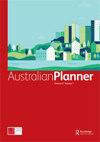Best practice in urban transport decarbonisation: a case study of three initiatives in Brisbane
IF 1.5
Q2 Social Sciences
引用次数: 1
Abstract
ABSTRACT Avoiding the worst impacts of climate change requires a transition to net-zero greenhouse gas emissions by mid-century, if not before. Urban transport systems are a significant contributor to emissions, so effective mitigation strategies for this sector are needed. This paper starts by outlining a best practice framework for transport decarbonisation based upon a review of the international research literature that entails: shifting passengers to net-zero or low-emission modes; investing in more energy-efficient technology options; and managing the demand for transport through a combination of land-use planning and socioeconomic policies. This best practice framework is then applied to a case study conducted in Brisbane (Australia) to see how the gap between the concepts developed in the research literature and the practice of making a change may be bridged. A policy analysis of three key transport initiatives in the city was undertaken to determine how they measure up against the best practice framework. On the positive side, Brisbane has the advantage of providing a reasonably reliable public transport system, expanding its bicycle/walking paths and engaging local communities in the decision-making and implementation. However, Brisbane faces a high degree of urban sprawl and car dependency, exacerbating its ecological footprint. Key Points: Urban transport is not sustainable and needs to be decarbonised. This requires a framework of practical solutions to assist transport planners and policymakers in moving towards a more sustainable, low-emission future. The best practice framework for transport decarbonisation entails shifting commuters to low-emission transport options, investing in more energy-efficient vehicles, and managing the demand for transport. Brisbane has geographically extensive and reasonably reliable public transport systems and community engagement processes, but the city is challenged by urban sprawl and car dependency.城市交通脱碳的最佳实践:布里斯班三项举措的案例研究
摘要要避免气候变化的最严重影响,即使不是在本世纪中叶,也需要实现温室气体净零排放。城市交通系统是排放的重要贡献者,因此需要为该部门制定有效的缓解策略。本文首先概述了交通脱碳的最佳实践框架,该框架基于对国际研究文献的回顾,包括:将乘客转变为净零排放或低排放模式;投资于更节能的技术选择;通过土地利用规划和社会经济政策相结合来管理交通需求。然后,将这一最佳实践框架应用于在布里斯班(澳大利亚)进行的案例研究,以了解如何弥合研究文献中提出的概念与做出改变的实践之间的差距。对该市的三项关键交通举措进行了政策分析,以确定它们如何符合最佳实践框架。从积极的方面来看,布里斯班的优势在于提供了一个合理可靠的公共交通系统,扩大了自行车/步行道,并让当地社区参与决策和实施。然而,布里斯班面临着高度的城市扩张和对汽车的依赖,加剧了其生态足迹。要点:城市交通是不可持续的,需要脱碳。这需要一个切实可行的解决方案框架,以帮助交通规划者和政策制定者朝着更可持续、低排放的未来迈进。交通脱碳的最佳实践框架包括将通勤者转向低排放交通选择,投资于更节能的车辆,并管理交通需求。布里斯班拥有地理上广泛且合理可靠的公共交通系统和社区参与流程,但该市面临着城市扩张和汽车依赖的挑战。
本文章由计算机程序翻译,如有差异,请以英文原文为准。
求助全文
约1分钟内获得全文
求助全文

 求助内容:
求助内容: 应助结果提醒方式:
应助结果提醒方式:


